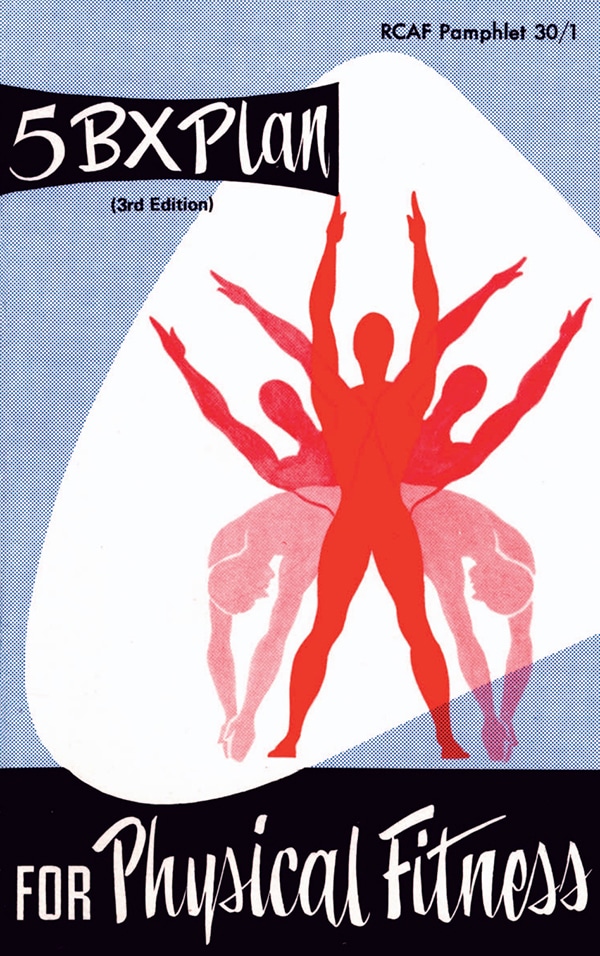
In last month’s AoM podcast episode with Dr. Martin Gibala about high-intensity interval training, he mentioned a high-intensity workout program that was developed by the Royal Canadian Air Force during the late 1950s, took only eleven minutes to perform, and became hugely popular with the civilian population. Duly intrigued, we decided to dig up the program to see what it involved.
The 5BX plan (Five Basic Exercises) was born out of a particular need: a third of the RCAF’s pilots were deemed unfit to fly and needed a workout program that 1) could be done without any specialized equipment, as the pilots were often stationed at remote bases without access to standard gyms, and 2) could fit into airmen’s busy schedules.
While high-intensity training hadn’t yet won mainstream acceptance, the pioneering research of Dr. Bill Orban had showed that by increasing the intensity of exercise, people could get the same fitness-improving benefits in much less time. Orban used this insight to develop 5BX, which involved doing five exercises — four of which targeted flexibility and strength and one that worked aerobic capacity — in just eleven minutes. The Canadian military encouraged not only its pilots to perform it, but their children as well. Orban also developed a plan for women called XBX, which involved doing ten exercises in 12 minutes.
In the 1960s, the programs were published together as the Royal Canadian Air Force Exercise Plans and distributed outside the military. The booklet became popular with civilians not only in Canada but around the world; it was translated into thirteen languages, sold 23 million copies, and is credited with helping to launch our modern fitness culture.
If you’d like to try it out, we’ve reformatted and republished the 5BX plan below. It features six “charts,” each of which includes the program’s five main exercises:
- Stretching
- Sit-up
- Back extension
- Push-up
- Running in place, interspersed with various jumps (can be substituted for an actual run or walk)
Each chart offers progressively more difficult variations of the five exercises, and you work your way from one level of performance on a particular chart to the next, and then from one chart to the next. Charts 5 and 6 get into some elite-level athletics — good luck with those toe-touching jack jumps, friends.
For a visual demonstration of some of the exercises, watch this 1959 Royal Canadian Air Force training video.

The Five Basic Exercises (5BX) Plan presented in this booklet is designed to show you how to develop and hold a high level of physical fitness, regardless of where you may be located. The scheme is not dependent on elaborate facilities or equipment. The exercises require only eleven minutes a day and can be done in your bedroom or beside your bed in your barracks.
The diversity of work assignments, combined with lack of adequate gymnasium facilities at many of your stations makes it difficult to schedule formal physical training periods for all our personnel. The 5BX Plan puts physical fitness training within reach of every member of the RCAF.
It is your duty and responsibility as a member of the RCAF to maintain a high level of physical fitness and be ready for any emergency which may require the extended use of your physical resources. Positive physical well-being is also closely allied with mental and emotional fitness, all of which are essential in the discharge of normal daily tasks.

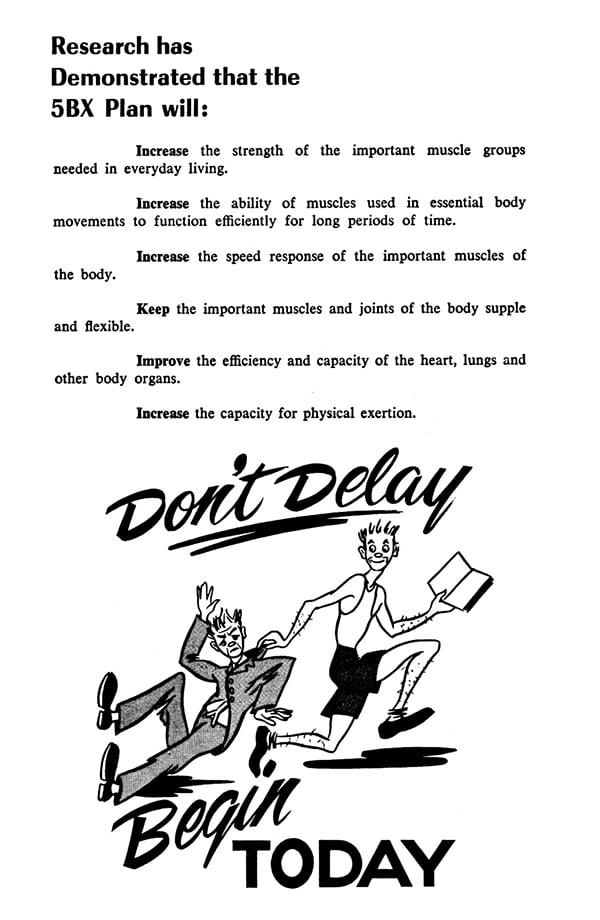
Warming Up
The 5BX Plan was designed so that no additional warmup is necessary in order to receive its maximum benefits.
The older one is, the more necessary proper warming up becomes to avoid “strained” muscles. The 5BX Plan has a built-in method of warmup. This is achieved in two ways:
- by the arrangement of the exercises; and
- by the manner in which these exercises are performed.
For example, the first exercise is a stretching and loosening exercise which limbers up the large muscles of the body. In addition, this exercise should be started very slowly and easily, with a gradual increase in speed and vigor.
Let us see how this principle applies to exercise No. 1, which requires you to touch the floor. You should not force yourself to do it on the first attempt, but rather start by pushing down very gently and slowly as far as you can without undue strain — then on each succeeding try push down a little harder, and, at the same time, do the exercise a little faster so that by the end of two minutes you are touching the floor and moving at the necessary speed. All the exercises can be performed in this manner.
What Is It?
The 5BX Plan is composed of 6 charts arranged in progression. Each chart is composed of 5 exercises which are always performed in the same order and in the same maximum time limit, but, as you progress from chart to chart, there are slight changes in each basic exercise with a gradual demand for more effort.
A sample rating scale for Chart 3 is reproduced below and is to be used in the following way:
![]()
These are the Physical Capacity levels, each indicated by a letter of the alphabet.
![]()
Exercises 1, 2, 3, and 4 apply to the first four exercises described and illustrated. The column headed 1 represents exercise 1 (toe touch), etc. The figures in each column indicate the number of times that each exercise is to be repeated in the time allotted for that exercise. Exercise 5 is running on the spot. Two activities may be substituted for it, however, and if you prefer, you may run or walk the recommended distance in the required time in place of the stationary run of exercise 5.

The allotted time for each exercise is noted here. These times remain the same throughout all the charts. Total time for exercises 1 through 5 is 11 minutes.
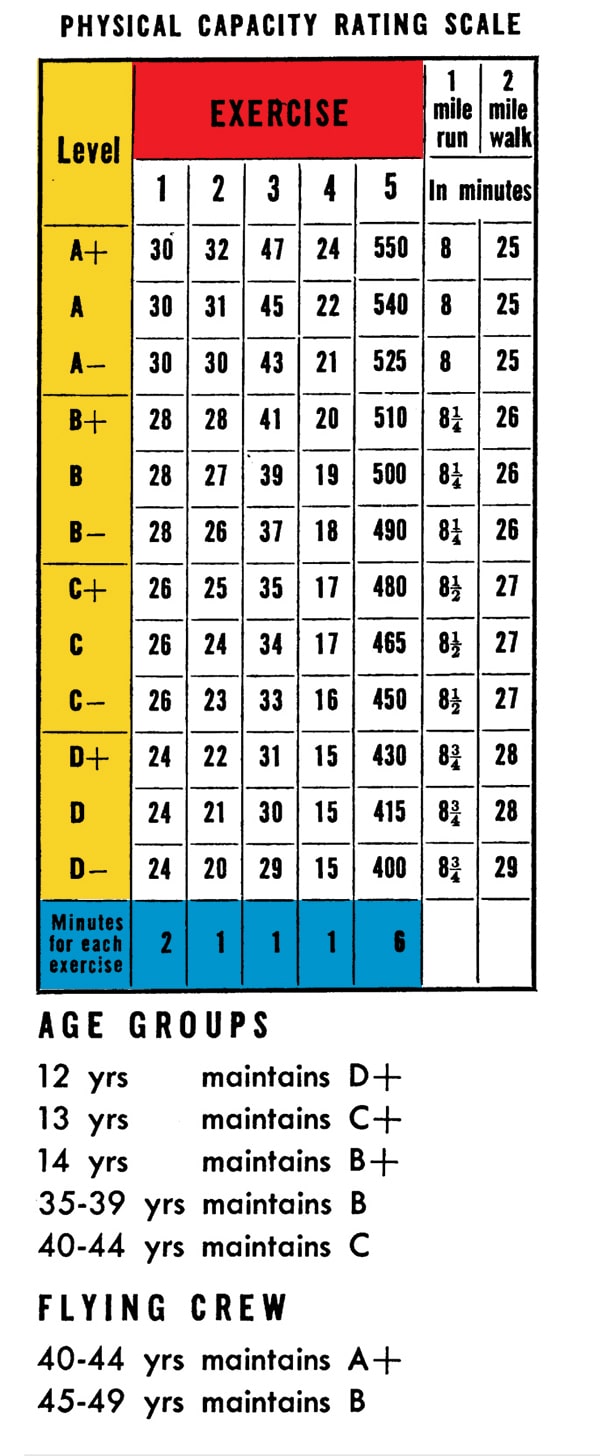
NOTE:
It is important that the exercises at any level be completed in 11 minutes. However, it is likely that in the early stages, an individual will complete certain exercises in less than the allotted time while others may require longer. In these circumstances, the times allotted for individual exercises may be varied within the total 11 minute period.
How Far Should You Progress?
The level of Physical Capacity to which you should progress is determined by your “Age Group.” Levels for “Flying Crew” are listed separately. See “Your Physical Capacity Level” below.
How to Begin
Check your daily schedule and determine the time most convenient for you to do the exercises. It should be the same time each day.
Here are some suggested times:
- Before breakfast
- Late morning or afternoon, at your place of employment
- After your regular recreational period
- In the evening just before you retire
Regardless of the time you choose, START TODAY.
Maximum Rate of Progression Through Chart 1 According to Age
- 20 years or under, at least 1 day at each level
- 20-29 years, at least 2 days at each level
- 30-39 years, at least 4 days at each level
- 40-49 years, at least 7 days at each level
- 50-59 years, at least 8 days at each level
- 60 years and over, at least 10 days at each level
(If you feel stiff or sore, or if you are unduly breathless at any time, ease up and slow down your rate of progression. This is particularly applicable to older age groups.)
A Note of Caution
Even if you feel able to start at a high level and progress at a faster rate then indicated — DON’T DO IT — Start at the bottom of chart 1 and work your way up from level to level as recommended.
For best results from 5BX, the exercises must be done regularly. Remember, it may take you 6, 8, 10 months or more of daily exercises to attain the level recommended for you, but once you have attained it, only 3 periods of exercise per week will maintain this level of physical capacity.
If for any reason (illness, etc.) you stop doing 5BX regularly and you wish to begin again, do not recommence at the level you had attained previously.
Do drop back several levels — until you find one you can do without undue strain. After a period of inactivity of longer than two months, or one month caused by illness, it is recommended that you start again at Chart 1.
How to Progress
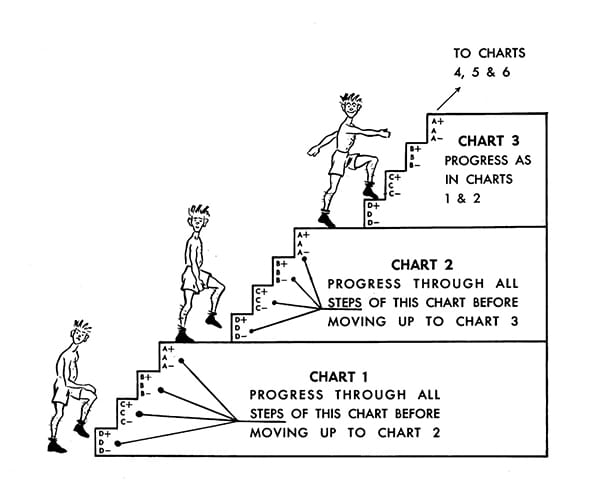
Start at the lowest Physical Capacity Level of Chart 1 (D-). Repeat each exercise in the allotted time or do the 5 exercises in 11 minutes. Move upward on the same chart to the next level (D) only after you can complete all the required movements at your present level within 11 minutes. Continue to progress upward in this manner until you can complete all the required movements at level A+ within 11 minutes. Now start at the bottom of Chart 2 (D-), and continue in this fashion upwards through the levels, and from chart to chart until you reach the level for your age group.
Chart 1
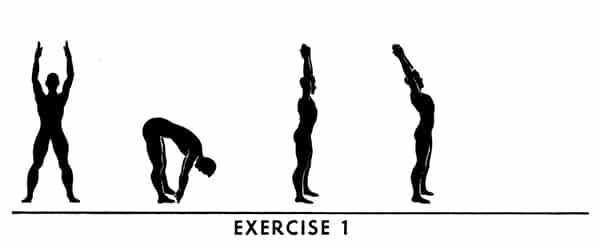
Feet astride, arms upward. Forward bend to floor touching then stretch upward and backward bend. Do not strain to keep knees straight.

Back lying, feet 6” apart, arms at sides. Sit up just far enough to see your heels. Keep legs straight, head and shoulders must clear the floor.

Front lying, palms placed under the thighs. Raise head and one leg, repeat using legs alternately. Keep leg straight at the knee, thighs must clear the palms. Count one each time second leg touches floor.

Front lying, hands under the shoulders, palms flat on the floor. Straighten arms lifting upper body, keeping the knees on the floor. Bend arms to lower body. Keep body straight from the knees, arms must be fully extended, chest must touch the floor to complete one movement.
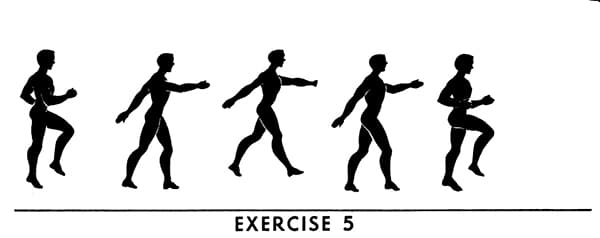
Stationary run. Count a step each time the left foot touches the floor. Lift feet approximately 4 inches off floor. Every 75 steps do 10 “scissor jumps.” Repeat this sequence until the required number of steps is completed.
Scissor jumps. Stand with right leg and left arm extended forward and left leg and right arm extended backward. Jump up and change position of arms and legs before landing. Repeat (arms shoulder high).
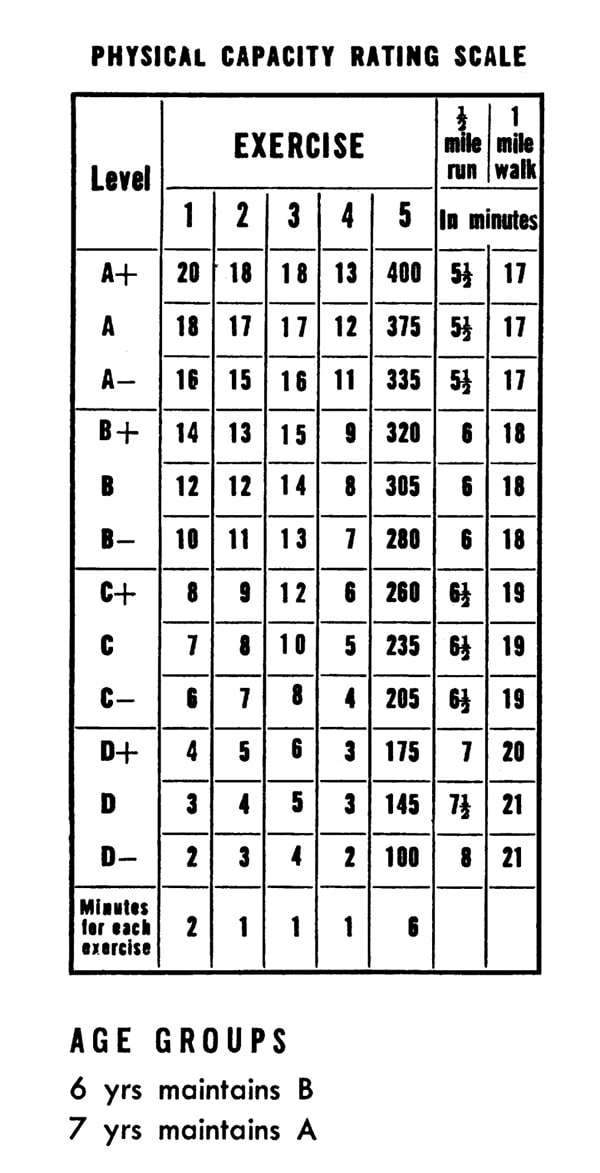
Chart 2
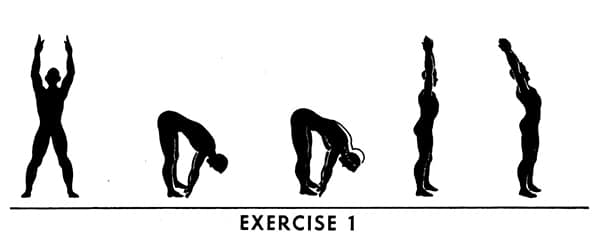
Feet astride, arms upward. Touch floor and press (bounce) once then stretch upward and backward bend. Do not strain to keep knees straight.

Back lying, feet 6” apart, arms at sides. “Sit up” to vertical position, keep feet on floor even if it is necessary to hook them under a chair. Allow knees to bend slightly.

Front lying, palms placed under thighs. Raise head, shoulders, and both legs. Keep legs straight, both thighs must clear the palms.

Front lying, hands under the shoulder, palms flat on floor. Straighten arms to lift body with only palms and toes on the floor. Back straight. Chest must touch the floor for each completed movement after arms have been fully extended.
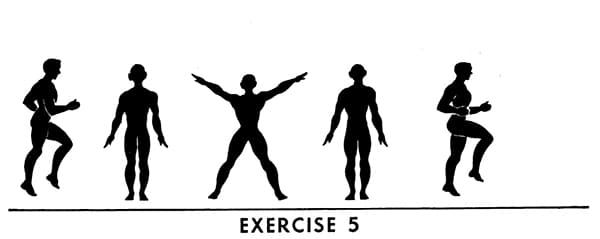
Stationary run. Count a step each time left foot touches the floor. Lift feet approximately 4 inches off floor. After every 75 steps, do 10 “astride jumps.” Repeat this sequence until required number of steps is completed.
Astride jumps. Feet together, arms at side. Jump and land with feet astride and arms raised sideways to slightly above shoulder height. Return with a jump to the starting position for count of one. Keep arms straight.
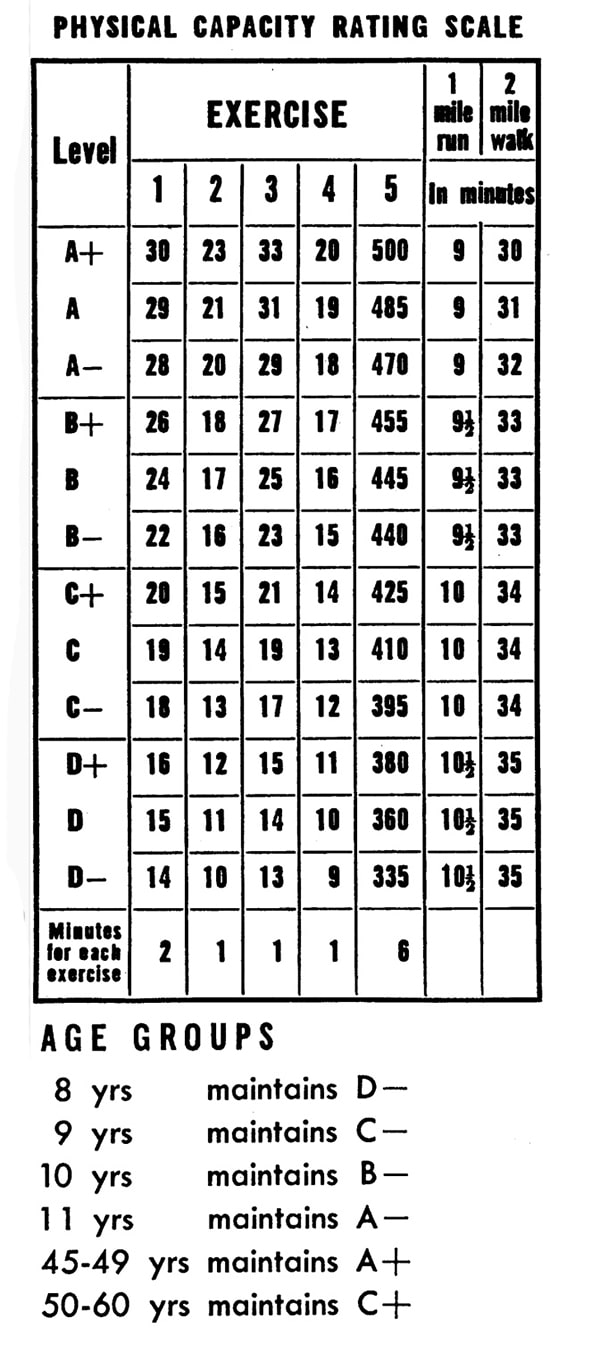
Chart 3
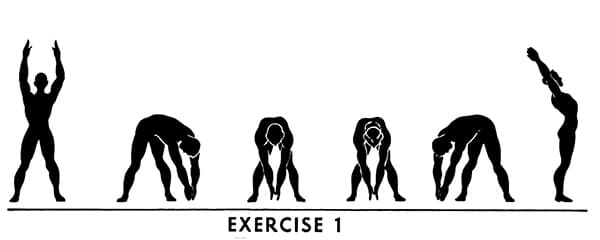
Feet astride, arms upward. Touch floor 6” outside left foot, again between feet and press once then 6” outside right foot, bend backward as far as possible, repeat, reverse direction after half the number of counts. Do not strain to keep knees straight, return to erect position.

Back lying, feet 6” apart, arms clasped behind head. Allow knees to bend slightly. Sit up to vertical position, keep feet on floor, hook feet under chair, etc., only if necessary.

Front lying, hands interlocked behind the back. Lift head, shoulders, chest and both legs as high as possible. Keep legs straight, and raise chest and both thighs completely off floor.

Front lying, hands under the shoulders, palms flat on floor. Touch chin to floor in front of hands — touch forehead to floor behind hands before returning to up position. There are three definite movements, chin, forehead, arms straightened. DO NOT do in one continuous motion.
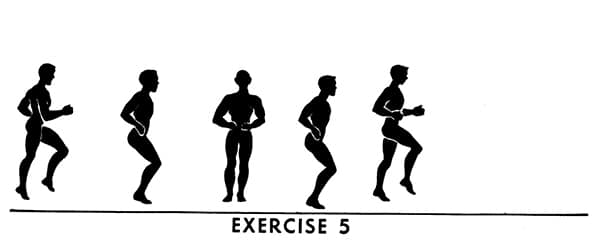
Stationary run. Count a step each time left foot touches the floor. Lift feet approximately 4 inches off floor. After every 75 steps, do 10 “half knee bends.” Repeat this sequence until required number of steps is completed.
Half knee bends. Feet together, hands on hips, knees bent to form an angle of about 110 degrees. Do not bend knees past a right angle. Straighten to upright position, raising heel off floor, return to starting position each time. Keep feet in contact with floor — the back upright and straight at all times.
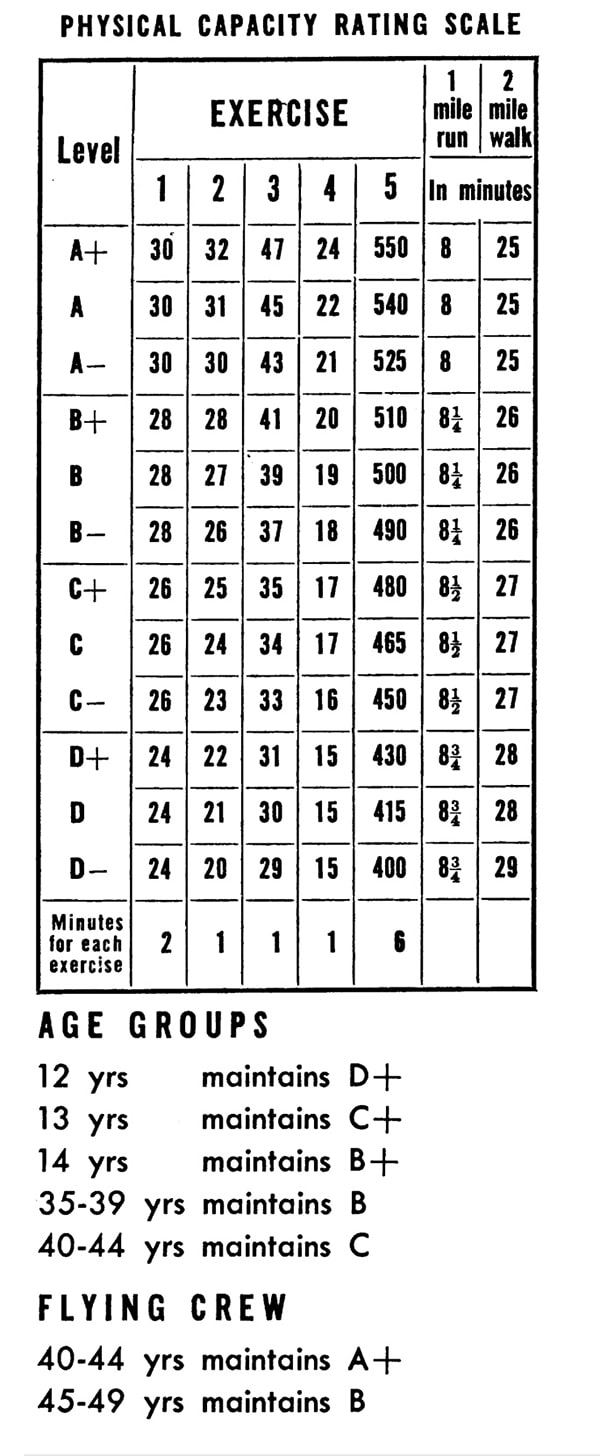
Chart 4
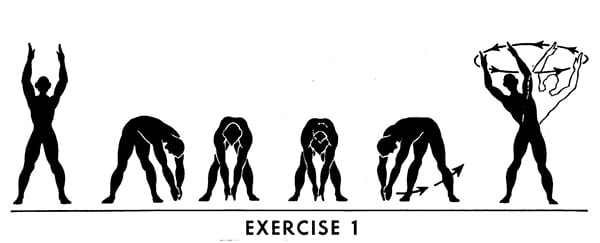
Feet astride, arms upward. Touch floor outside left foot, between feet, press once then outside right foot, circle bend backward as far as possible, reverse direction after half the number of counts. Do not strain to keep knees straight. Keep arms above head and make full circle, bending backward past vertical each time.

Back lying, legs straight, feet together, arms straight overhead. Sit up and touch the toes keeping the arms and legs straight. Use chair to hook feet under only if necessary. Keep arms in contact with the sides of the head throughout the movement. Allow knees to bend slightly.

Front lying, hands and arms stretched sideways. Lift head, shoulders, arms, chest and both legs as high as possible. Keep legs straight, raise chest and both thighs completely off floor.

Front lying, palms of hands flat on floor, approximately 1 foot from ears directly to side of head. Straighten arms to lift body. Chest must touch floor for each completed movement.
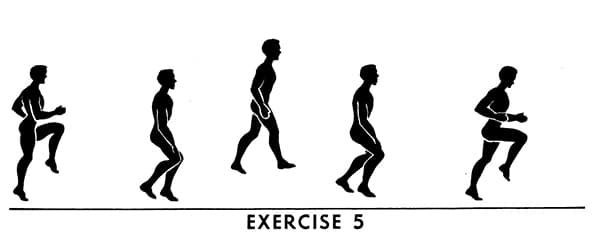
Stationary run. Count a step each time left foot touches the floor. Lift feet approximately 4 inches off floor. After every 75 steps, do 10 “semi-squat jumps.” Repeat this sequence until required number of steps is completed.
Semi-squat jumps. Drop to a half crouch position with hands on knees and arms straight, keep back as straight as possible, right foot slightly ahead of left. Jump to upright position with body straight and feet leaving floor. Reverse position of feet before landing. Return to half crouch position and repeat.
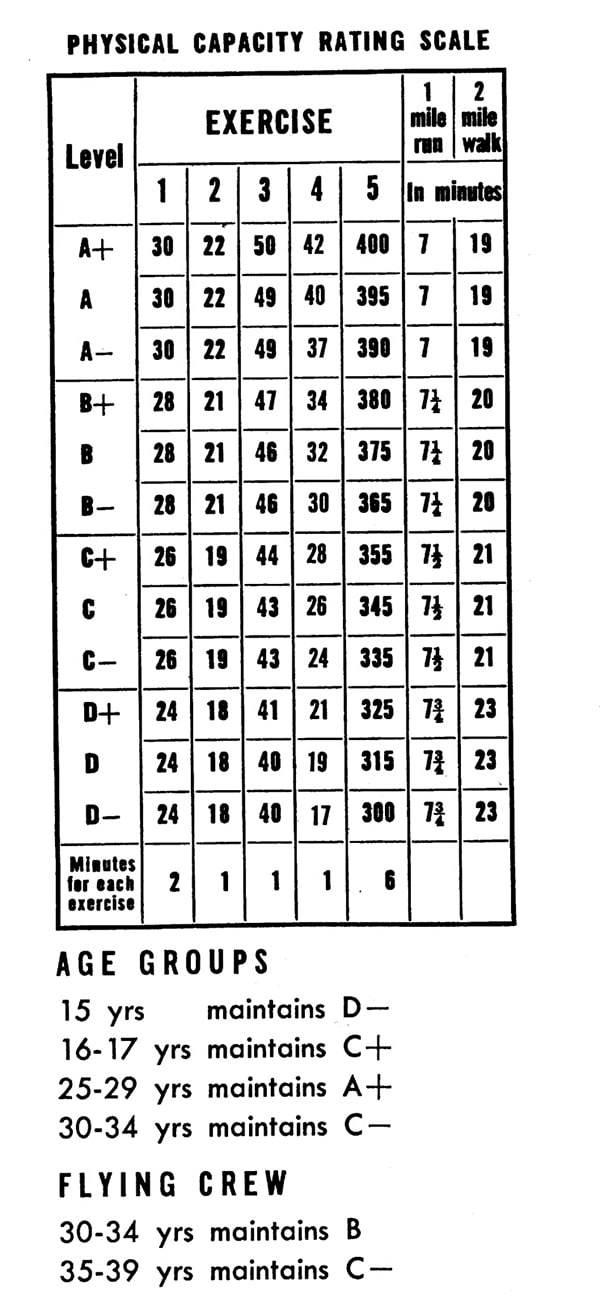
Chart 5
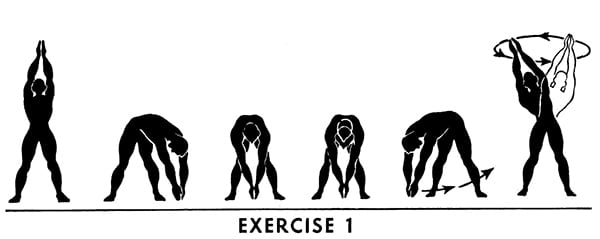
Feet astride, arms upward, hands collapsed, arms straight. Touch floor outside left foot, between feet, press once then outside right foot, circle bend backwards as far as possible. Reverse direction after half the number of counts. Do not strain to keep knees straight.

Back lying, legs straight, feet together, hands clasped behind head. Sit up and raise legs in bent position at same time twist to touch right elbow to left knee. This completes one movement. Alternate the direction of twist each time. Keep feet off floor when elbow touches knee.

Front lying, arms extended overhead. Raise arms, head, chest, and both legs as high as possible. Keep legs and arms straight, chest and both thighs completely off floor.

Front lying, hands under the shoulder, palms flat on floor. Push off floor and clap hands before returning to starting position. Keep body straight during the entire movement. Hand clap must be heard.
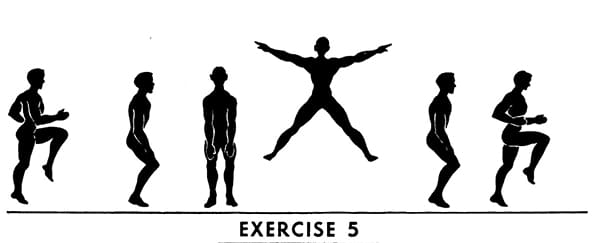
Stationary run. Count a step each time left foot touches floor. Lift feet approximately 4 inches off floor. After every 75 steps, do 10 “semi-spread eagle jumps.” Repeat this sequence until required number of steps is completed.
Semi-spread eagle jumps. Feet together, drop to a half crouch position hands on knees with arms straight. Jump up to feet astride swing arms overhead in mid-air, return directly to starting position on landing. Raise hands above head level, spread feet at least shoulder width apart in astride position before landing with feet together.

Chart 6

Feet astride, arms upward, hands reverse clasped, arms straight. Touch floor outside left foot, between feet, press once then outside right foot, circle bend backwards as far as possible. Reverse direction after half the number of counts. Keep hands tightly reverse clasped at all times.

Back lying, legs straight, feet together, arms straight over the head. Sit up and at the same time lifting both legs to touch the toes in a pike (V) position. Keep feet together, legs and arms straight, all of the upper back and legs clear floor, fingers touch toes each time.

Front lying, arms extended over head. Raise arms, head, chest, and both legs as high as possible then press back once. Keep legs and arms straight — chest and both thighs completely off floor.

Front lying, hands under shoulders, palms flat on floor. Push off floor and slap chest before returning to starting position. Keep body straight during the entire movement. Chest slap must be heard.
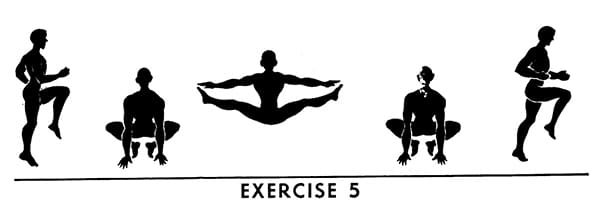
Stationary run. Count a step each time left foot touches the floor. Lift feet approximately 4 inches off floor. After every 75 steps, do 10 “jack jumps.” Repeat this sequence until required number of steps is completed.
Jack jumps. Feet together, knees bent, sit on heels, finger tips touch floor. Jump up, raise legs waist high, keep legs straight and touch toes in midair. Keep legs straight, raise feet level to “standing waist height.” Touch toes each time.
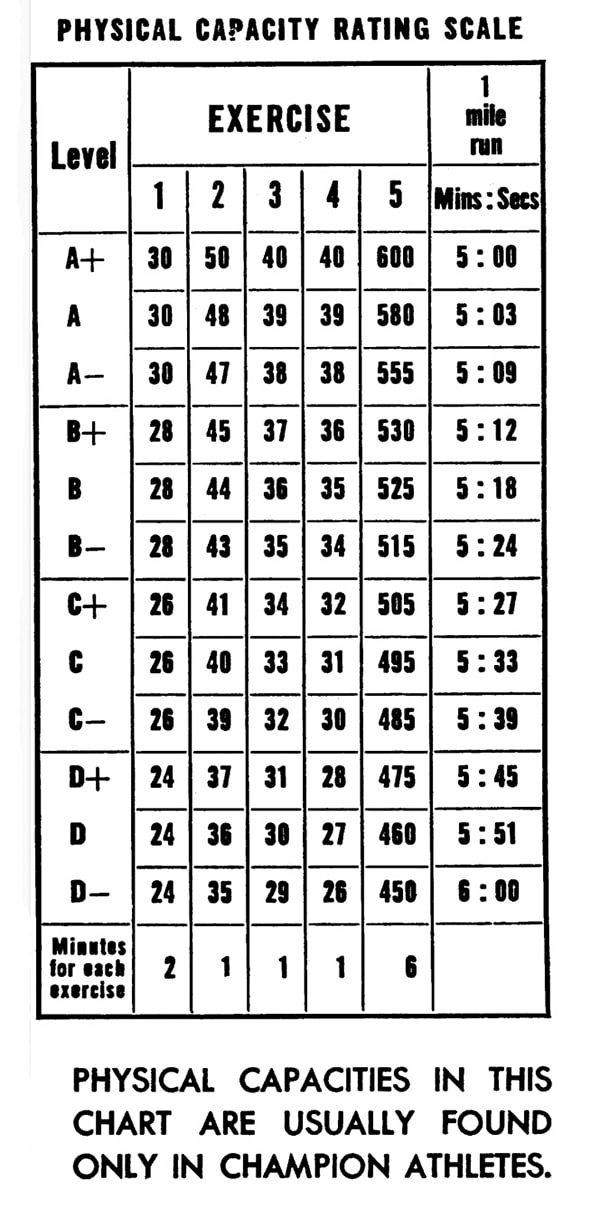
Your Physical Capacity Level
Each age group is given a Physical Capacity level to attain; that is, a goal which they should try to reach.
The Physical Capacity levels in this plan are based on the expectation of average individuals.
With every average, there are individuals who surpass it, and those who fall below it. In terms of the 5BX Plan and the goals, this means that there will be some men who are capable of progressing beyond the level indicated, and on the other hand, there will be persons who will never attain this average level.
If you feel able to move further through the charts than your Physical Capacity level, by all means do so. If, on the contrary, you experience great difficulty in approaching this level you should stop at a level which you feel to be within your capability. It is impossible to predict accurately, a level for each individual who uses this program. Use the goals as guides, and apply them with common sense.
Here are a few tips:
When you start, defeat the first desire to skip a day; then defeat all such desires as they occur. This exercise program has plenty of bite; the longer you do it the more you will enjoy it.
As you progress well into the program you may find certain levels impossible to complete in 11 minutes — work hard at that level — it may take some days or even weeks — then suddenly you will find yourself sailing ahead again.
Counting the steps in exercise 5 can be difficult. You can lose count very easily at times. If you have this problem, here is an easy way to overcome it. Divide the total number of steps required by 75 and note the answer—place a row of buttons, corresponding in number to this answer, on a handy table or chair. Now count off your first 75 steps—do your ten required movements—and move the first button. Repeat until all the buttons have been removed, finishing with any left over steps.
For diversity, occasionally an exercise from the previous chart may be substituted.
Wishing is not good enough.
Help support independent publishing. Make a donation to The Art of Manliness! Thanks for the support!
--------------------
By: Brett & Kate McKay
Title: 5BX: The Cold War Military Workout for Getting Fit in 11 Minutes a Day
Sourced From: www.artofmanliness.com/health-fitness/5bx-the-cold-war-military-workout-for-getting-fit-in-11-minutes-a-day/
Published Date: Tue, 19 Mar 2024 14:50:42 +0000
No comments:
Post a Comment